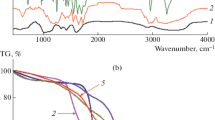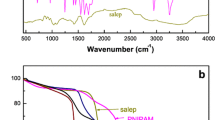Abstract
In this manuscript, synthesis, characterization, swelling behavior, and drug delivery performance of a gold nanocomposite hydrogel (GNH) based on poly(acrylic acid) grafted onto salep, as a biocompatible polymer, are described. Gold nanoparticles (AuNPs) as nanometer base, ammonium persulfate as an initiator, N,N-methylenebisacrylamide as a crosslinker, and acrylic acid as pH sensitive monomer were employed for the preparation of entitled GNH in aqueous solution and their amounts were optimized to reach the highest water absorbance. The synthesized GNHs were fully characterized by using FTIR spectroscopy, thermogravimetric analysis, EDAX spectrum, SEM, TEM, and AFM images, and a mechanism for superabsorbent hydrogel nanocomposite formation was suggested. Swelling kinetics in double-distilled water and the absorbency were also investigated. Furthermore, the on–off switching behaviors of the nanocomposite at different pHs were investigated. Doxorubicin hydrochloride is a chemotherapeutic drug and a hydrophilic molecule, with nitrogen and oxygen in its chemical structure. Because nitrogen and oxygen can bind to gold surfaces with high affinity, most frequently nitrogen- and oxygen-modified ligands are used as stabilizing agents, which interact with the surface of the AuNPs by formation of Au–nitrogen and Au–oxygen bonds. This Au nanoparticle–drug conjugate can be incorporated into the bio-based hydrogel matrices to make a hydrogel nanocomposite system. The pH response of this GNH makes it suitable for acting as a controlled drug delivery system. Furthermore, the role of AuNPs in effective release of doxorubicin is discussed by comparing the release in hydrogel and nanocomposite systems.














Similar content being viewed by others
References
Hennink W, Van Nostrum CF (2012) Novel crosslinking methods to design hydrogels. Adv Drug Deliv Rev 64:223–236
Guo J, ** YC, Yang XQ, Yu SJ, Yin SW, Qi JR (2013) Computed microtomography and mechanical property analysis of soy protein porous hydrogel prepared by homogenizing and microbial transglutaminase cross-linking. Food Hydrocoll 31(2):220–226
Guilherme MR, Reis AV, Takahashi SH, Rubira AF, Feitosa JP, Muniz EC (2005) Synthesis of a novel superabsorbent hydrogel by copolymerization of acrylamide and cashew gum modified with glycidyl methacrylate. Carbohydr Polym 61(4):464–471
Yao KJ, Zhou WJ (1994) Synthesis and water absorbency of the copolymer of acrylamide with anionic monomers. J Appl Polym Sci 53(11):1533–1538
Qiu Y, Park K (2001) Environment-sensitive hydrogels for drug delivery. Adv Drug Deliv Rev 53(3):321–339
Chen J, Zhao Y (2000) Relationship between water absorbency and reaction conditions in aqueous solution polymerization of polyacrylate superabsorbents. J Appl Polym Sci 75(6):808–814
Li A, Wang A (2005) Synthesis and properties of clay-based superabsorbent composite. Eur Polym J 41(7):1630–1637
Bardajee GR, Pourjavadi A, Soleyman R, Ghavami S (2012) Salep-g-poly (sodium acrylate)/alumina as an environmental-sensitive biopolymer superabsorbent composite: synthesis and investigation of its swelling behavior. Adv Polym Technol 31(1):41–51
Gil ES, Frankowski DJ, Spontak RJ, Hudson SM (2005) Swelling behavior and morphological evolution of mixed gelatin/silk fibroin hydrogels. Biomacromolecules 6(6):3079–3087
Naskar J, Palui G, Banerjee A (2009) Tetrapeptide-based hydrogels: for encapsulation and slow release of an anticancer drug at physiological pH. J Phys Chem B 113(35):11787–11792
David L, Dulong V, Le Cerf D, Cazin L, Lamacz M, Vannier JP (2008) Hyaluronan hydrogel: an appropriate three-dimensional model for evaluation of anticancer drug sensitivity. Acta Biomater 4(2):256–263
Chen YY, Wu HC, Sun JS, Dong GC, Wang TW (2013) Injectable and thermoresponsive self-assembled nanocomposite hydrogel for long-term anticancer drug delivery. Langmuir 29(11):3721–3729
Mahdavinia GR, Marandi GB, Pourjavadi A, Kiani G (2010) Semi-IPN carrageenan-based nanocomposite hydrogels: synthesis and swelling behavior. J Appl Polym Sci 118(5):2989–2997
Zhou C, Wu Q (2011) A novel polyacrylamide nanocomposite hydrogel reinforced with natural chitosan nanofibers. Colloids Surf B: Biointerfaces 84(1):155–162
Zhang Y-T, Zhi T-T, Zhang L, Huang H, Chen H-L (2009) Immobilization of carbonic anhydrase by embedding and covalent coupling into nanocomposite hydrogel containing hydrotalcite. Polymer 50(24):5693–5700
Wang Y, Chen D (2012) Preparation and characterization of a novel stimuli-responsive nanocomposite hydrogel with improved mechanical properties. J Colloid Interface Sci 372(1):245–251
Zhang J, Li A, Wang A (2006) Study on superabsorbent composite. VI. Preparation, characterization and swelling behaviors of starch phosphate-graft-acrylamide/attapulgite superabsorbent composite. Carbohydr Polym 65(2):150–158
Shin J, Lim YM, Jeun J, Nho YC (2007) Swelling behavior study of gamma-irradiated gelatin hydrogels prepared in organic/aqueous mixtures. Journal of Industrial and Engineering Chemistry-Seoul 13(6):997–1001
Wang C-Y, Huang H-W, Hsu C-P, Shyu Y-T, Yang BB (2013) Inactivation and morphological damage of Vibrio parahaemolyticus treated with high hydrostatic pressure. Food Control 32(2):348–353
Zheng K, Zou A, Yang X, Liu F, **a Q, Ye R, Mu B (2013) The effect of polymer–surfactant emulsifying agent on the formation and stability of α-lipoic acid loaded nanostructured lipid carriers (NLC). Food Hydrocoll 32(1):72–78
Dunjic-Kostic B, Ivkovic M, Radonjic NV, Petronijevic ND, Pantovic M, Damjanovic A, Poznanovic ST, Jovanovic A, Nikolic T, Jasovic-Gasic M (2013) Melancholic and atypical major depression—connection between cytokines, psychopathology and treatment. Prog Neuro-Psychopharmacol Biol Psychiatry 43:1–6
Yu S-H, Hsieh H-Y, Pang J-C, Tang D-W, Shih C-M, Tsai M-L, Tsai Y-C, Mi F-L (2013) Active films from water-soluble chitosan/cellulose composites incorporating releasable caffeic acid for inhibition of lipid oxidation in fish oil emulsions. Food Hydrocoll 32(1):9–19
Zhang S-M, Coultas KA (2013) Identification of plumbagin and sanguinarine as effective chemotherapeutic agents for treatment of schistosomiasis. International Journal for Parasitology: Drugs and Drug Resistance 3:28–34
Luo Y, Teng Z, Wang X, Wang Q (2013) Development of carboxymethyl chitosan hydrogel beads in alcohol-aqueous binary solvent for nutrient delivery applications. Food Hydrocoll 31(2):332–339
Jung J, Arnold RD, Wicker L (2013) Pectin and charge modified pectin hydrogel beads as a colon-targeted drug delivery carrier. Colloids Surf B: Biointerfaces 104:116–121
Bardajee GR, Hooshyar Z, Rezanezhad H (2012) A novel and green biomaterial based silver nanocomposite hydrogel: synthesis, characterization and antibacterial effect. J Inorg Biochem 117:367–373
Bardajee GR, Pourjavadi A, Ghavami S, Soleyman R, Jafarpour F (2011) UV-prepared salep-based nanoporous hydrogel for controlled release of tetracycline hydrochloride in colon. J Photochem Photobiol B Biol 102(3):232–240
Li K, Yu L, Liu X, Chen C, Chen Q, Ding J (2013) A long-acting formulation of a polypeptide drug exenatide in treatment of diabetes using an injectable block copolymer hydrogel. Biomaterials 34(11):2834–2842
Wang Y, Zhang Z, Xu L, Li X, Chen H (2013) Hydrogels of halogenated Fmoc-short peptides for potential application in tissue engineering. Colloids Surf B: Biointerfaces 104:163–168
Bardajee GR, Pourjavadi A, Soleyman R (2011) Novel nano-porous hydrogel as a carrier matrix for oral delivery of tetracycline hydrochloride. Colloids Surf A Physicochem Eng Asp 392(1):16–24
Conti B, Colzani B, Papetti A, Mascherpa D, Dorati R, Genta I, Pruzzo C, Signoretto C, Zaura E, Lingström P (2013) Adhesive microbeads for the targeting delivery of anticaries agents of vegetable origin. Food Chem 138(2):898–904
Jana S, Saha A, Nayak AK, Sen KK, Basu SK (2013) Aceclofenac-loaded chitosan-tamarind seed polysaccharide interpenetrating polymeric network microparticles. Colloids Surf B: Biointerfaces 105:303–309
Gurunathan S, Han JW, Eppakayala V, Kim J-H (2013) Biocompatibility of microbially reduced graphene oxide in primary mouse embryonic fibroblast cells. Colloids Surf B: Biointerfaces 105:58–66
Kaya S, Tekin AR (2001) The effect of salep content on the rheological characteristics of a typical ice-cream mix. J Food Eng 47(1):59–62
Ktistis G, Georgakopoulos P (1991) Rheology of salep mucilages. Pharmazie 46(1):55–56
Farhoosh R, Riazi A (2007) A compositional study on two current types of salep in Iran and their rheological properties as a function of concentration and temperature. Food Hydrocoll 21(4):660–666
Hiramatsu H, Osterloh FE (2004) A simple large-scale synthesis of nearly monodisperse gold and silver nanoparticles with adjustable sizes and with exchangeable surfactants. Chem Mater 16(13):2509–2511
Samal AK, Sreeprasad TS, Pradeep T (2010) Investigation of the role of NaBH4 in the chemical synthesis of gold nanorods. J Nanopart Res 12(5):1777–1786
Pourjavadi A, Ghasemzadeh H, Soleyman R (2007) Synthesis, characterization, and swelling behavior of alginate-g-poly (sodium acrylate)/kaolin superabsorbent hydrogel composites. J Appl Polym Sci 105(5):2631–2639
Flory PJ (1953) Principles of polymer chemistry. Cornell University Press, New York
Athawale V, Lele V (1998) Graft copolymerization onto starch. II. Grafting of acrylic acid and preparation of it's hydrogels. Carbohydr Polym 35(1):21–27
Pourjavadi A, Harzandi A, Hosseinzadeh H (2004) Modified carrageenan 3. Synthesis of a novel polysaccharide-based superabsorbent hydrogel via graft copolymerization of acrylic acid onto kappa-carrageenan in air. Eur Polym J 40(7):1363–1370
Kabiri K, Zohuriaan-Mehr M (2003) Superabsorbent hydrogel composites. Polym Adv Technol 14(6):438–444
Odian G (1981) Principles of polymerization, 2nd edn. Wiley-Interscience, New York
Omidian H, Hashemi S, Sammes P, Meldrum I (1998) A model for the swelling of superabsorbent polymers. Polymer 39(26):6697–6704
Bardajee GR, Pourjavadi A, Soleyman R, Sheikh N (2010) Gamma irradiation mediated synthesis of a new superabsorbent hydrogel network based on poly (acrylic acid) grafted onto salep. J Iran Chem Soc 7(3):652–662
McCarty MF, Whitaker J (2010) Manipulating tumor acidification as a cancer treatment strategy. Altern Med Rev 15(3):264–272
Serra L, Doménech J, Peppas NA (2006) Drug transport mechanisms and release kinetics from molecularly designed poly (acrylic acid-g-ethylene glycol) hydrogels. Biomaterials 27(31):5440–5451
Acknowledgements
We are grateful to the PNU and INSF for funding this work.
Author information
Authors and Affiliations
Corresponding author
Rights and permissions
About this article
Cite this article
Bardajee, G.R., Mizani, F. & Hosseini, S.S. pH sensitive release of doxorubicin anticancer drug from gold nanocomposite hydrogel based on poly(acrylic acid) grafted onto salep biopolymer. J Polym Res 24, 48 (2017). https://doi.org/10.1007/s10965-017-1197-4
Received:
Accepted:
Published:
DOI: https://doi.org/10.1007/s10965-017-1197-4




